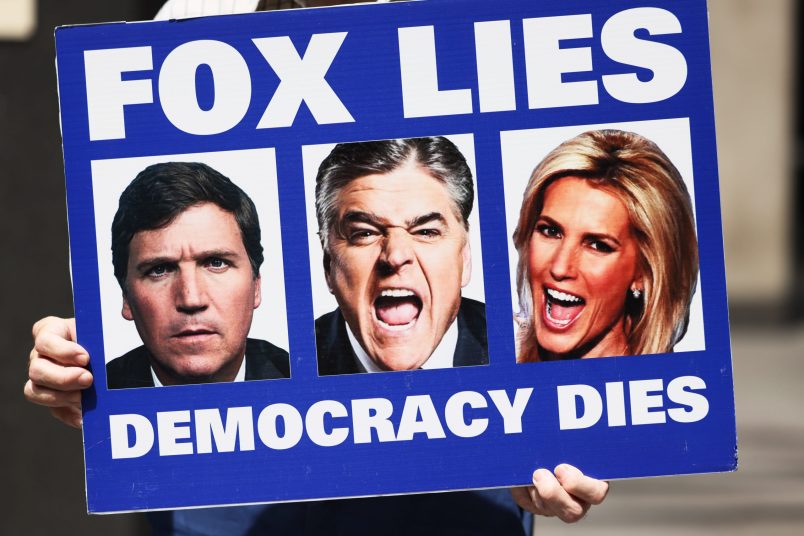The evidence emerging from the Dominion lawsuit against Fox News has the quality of liberal fever dreams. What’s the worst you can possibly imagine about Fox? What’s the most cartoonish caricature, the worst it could possibly be? Well, in these emails and texts you basically have that. Only it’s real. It’s not anyone believing the worst and giving no benefit of the doubt. This is what Fox is.
In a moment like this it’s worth stepping way, way back, not just to the beginning of Fox News in 1996 but to the beginning of the broader countermovement it was a part of and even a relatively late entry to.
Back in the 1950s and 1960s there was something historians and critics of the time called the post-war liberal consensus. It was not liberal in ways we’d recognize today. Indeed, it wasn’t liberal in many ways actual liberals of the time recognized. But it did represent an important level of elite consensus about state intervention in the economy and openness to a more restrained version of the American state created by the reformist periods of the first half of the 20th century.
Though what was then sometimes called “the race question” was “complicated” and not something that could be resolved overnight, there was also in elite opinion a general assumption that the South’s system of legalized apartheid was a source of embarrassment and something from the past that the country had to outgrow, even if not any time soon. (Just as is the case today, what is actually more properly called cosmopolitanism was sometimes misportrayed as liberalism: a general belief in pluralism, values tied to cities and urban life.)
I mention all this because, in the early 1950s and 1960s, what we now recognize as the embryonic modern conservative movement could rightly sense that there were assumptions embedded in elite culture that viewed certain of their core values and aims as backward, retrograde, archaic. When the early founders of modern “movement” conservatism looked at America’s elite consensus, they saw a set of assumptions and beliefs embedded in many elite institutions that ran counter to their aims and values. And they were not totally wrong.
Over the course of the 1960s and 1970s they set about trying to build a series of counter-institutions, ones that wouldn’t, in their mind, have their sails angled permanently toward the winds of liberalism. One key moment in this story was the founding of The Heritage Foundation in 1973. Heritage was founded to be the counter to the “liberal” Brookings Institution. But Heritage was never anything like Brookings, even though in the D.C. of the ’80s and ’90s they were routinely portrayed as counterpoints — one representing liberalism and the other conservatism. Brookings was mainstream, stodgy, quasi-academic. Heritage was thoroughly ideological and partisan. In practice it was usually little more than a propaganda mill for the right. This pattern was duplicated countless times. The “liberal” Washington Post was matched by The Washington Times. Fox News, which didn’t come along for another generation, was not so much the answer to CNN as to CBS News, the iconic broadcast news organization of the first decades of the Cold War.
What we see today in Fox News is most of the story: a purported news organization that knowingly and repeatedly reports lies to its viewers, whose chief executive brazenly works with and assists one party’s candidates by sharing confidential information about the other. What has always been the tell about Fox News is the tagline and motto: fair and balanced. The operation’s very branding is an aggressive bit of trolling. An unabashedly partisan and ideological operation selling itself under the heading of “fair and balanced.” It’s less a lie than a knowing taunt.
Here we get to the nub of the issue. Because this is not the entirety of the story. One of the things that is clear from the very start of the conservative movement was a basic failure to quite understand the thing they rallied themselves against, the history that in Bill Buckley’s famous phrase he was standing athwart and yelling “Stop!” None of the organizations that the right took issue with — the think tanks, the news publications, the movie studios, the nonprofits, the book publishers — were ideological, let alone partisan, organizations. When the founders of modern conservatism looked at CBS News they saw the shock troops of liberalism and the Democratic Party. Same with Brookings and the Washington Post and all the rest. And when they went to build their own versions of these institutions they patterned them off their own cartoonish understandings of how these operations functioned. The idea that institutions like CBS News or The New York Times were, whatever their faults and unexamined biases, fundamentally rooted in an ethic of news gathering and reporting was really totally lost on them.
So how do we get from this elemental misunderstanding to the raw and casual lying of the Fox of today? Well, that’s the thing: we don’t. Both were there from the very start. It’s all but impossible to disentangle the culture clash, the inability and refusal to really grasp what these institutions were, and the more open culture of propaganda, lying and mendacity. They’re fused together so tightly that getting your head around the relationship between them is more a matter of meditative absorption than anything that can be processed or explained discursively.
One further nugget brings the story nearer to our time from the distant past of the early Cold War and the origins of modern conservatism. Today we know Tucker Carlson as the preppy boyishly middle aged white nationalist who is the current center of gravity to Fox News. But that wasn’t always his public presentation. Always a conservative, his younger incarnation held an air of ironic and quasi-urbane detachment from full wingnut intensity. Back in February 2009, in a moment of mid-career identity crisis, he gave a speech at CPAC which bundled together much of what we’re discussing here. The fact that no one took conservative news organizations and journalists seriously, he told the crowd, wasn’t a matter of liberal bias or anything about the establishment. It was because they weren’t really journalists. Needless to say, he wasn’t speaking to a terribly receptive audience. “If you create a news organization whose primary objective is not to deliver accurate news, you will fail,” he said. “The New York Times is a liberal paper, but it is also…a paper that actually cares about accuracy. Conservatives need to build institutions that mirror those institutions.”
As you can see in this clip, this wasn’t really a condemnation of conservative news outlets. He actually praises Fox and he sort of jumps back and forth in response to boos from the crowd. But there was some getting at the root of the matter.
As soon became clear, Carlson was not only the John the Baptist of this clarion call but the Jesus too. A year later he launched The Daily Caller expressly on the model of the speech he’d given a year earlier at CPAC. But what quickly became clear is that there was little audience, market or demand for that kind of conservative publication. To whatever extent Carlson had ever really been committed to creating that kind of publishing operation, he quickly lost patience with it and shifted gears to the publication we’ve been familiar with for the last dozen years: a slightly less transgressive and racist version of Breitbart. There simply wasn’t any future or money in that other kind of operation. So, after briefly trying to go semi-legit, he shifted gears and went full-steam-ahead into the white nationalism and lying business.
As I say, this duality has always been at the heart of conservative media. Carlson embodies it as much as anyone. And so it’s fitting that he’s at the heart of this most recent set of revelations.

 Members-Only Article
Members-Only Article

